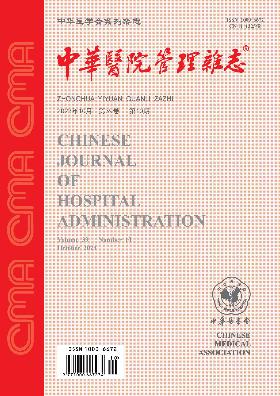Study on the driving factors and forming mechanism of the willingness for primary doctors to make initial diagnosis
引用次数: 0
Abstract
Objective Based on the KAP and Prospect theory, to explore, construct and verify the theoretical model and formation mechanism of driving factors of primary care doctors′ willingness to carry out the primary diagnosis. Methods Using the random cluster sampling method, from April to May 2019, a questionnaire survey was conducted among doctors at 20 primary medical and health service institutions in Hangzhou. The survey covered the primary care doctors′ cognition level of primary diagnosis, their self-evaluation of primary medical care capabilities, evaluation of policies and systems, expectation of primary medical care, and their job satisfaction. Descriptive statistic, multiple linear regression and structural equation model were used to analyze and explore the driving factors and formation mechanism of their willingness to carry out the primary diagnosis. Results Primary care doctors′ willingness rate for primary diagnosis was 76.4%(308/403). Positive expectation(beta=0.309), cognition level(beta=0.216), evaluation of policies and systems(beta=0.184), and self-evaluation of primary diagnosis capability(beta=0.170), all of which directly affect the said willingness. The total effect of the five types of driving factors on the willingness of the primary diagnosis was as follows: cognitive level of the primary diagnosis(0.536), evaluation of the policy system(0.494), self-evaluation of the primary diagnosis capability(0.436), positive expectations of the primary diagnosis work(0.186), job satisfaction(0.146). Conclusions The cognition of the primary diagnosis, the capability of the primary diagnosis, the policy system and the positive expectation are the important premises, key driving forces, and a strong guarantee and motivation to drive primary care doctors to carry out the primary diagnosis. It is suggested that the government and medical institutions should further improve the cognition level of primary care doctors, focusing on systematically improving the service capability of primary care doctors′ primary consultation, coordinating to improve policy guidance measures such as financial input, medical insurance reimbursement and referral system, establishing and improving incentive measures such as career development, performance appraisal, salary and welfare of primary care doctors. Key words: Initial diagnosis at primary level; Intention of initial diagnosis; Driving factors; Mechanism; Structural equation model基层医生初诊意愿的驱动因素及形成机制研究
目的以KAP和Prospect理论为基础,探索、构建和验证初级保健医生进行初级诊断意愿驱动因素的理论模型和形成机制。方法采用随机整群抽样方法,于2019年4月至5月对杭州市20家基层医疗卫生服务机构的医生进行问卷调查。调查涵盖了初级保健医生对初级诊断的认知水平、对初级保健能力的自我评价、对政策和制度的评价、对初级医疗保健的期望以及他们的工作满意度。采用描述性统计、多元线性回归和结构方程模型,分析和探讨他们愿意进行初级诊断的驱动因素和形成机制。结果基层医生对基层诊断的意愿率为76.4%(308/403),积极期望(β=0.309)、认知水平(β=0.216)、政策制度评价(β=0.184)、基层诊断能力自评(β=0.170),均直接影响基层诊断意愿。五类驱动因素对初级诊断意愿的总体影响如下:初级诊断认知水平(0.536)、政策体系评价(0.494)、初级诊断能力自我评价(0.436)、对初级诊断工作的积极期望(0.186),工作满意度(0.146)。结论对初级诊断的认知、初级诊断的能力、政策体系和积极期望是推动初级保健医生进行初级诊断的重要前提和关键驱动力,是推动初级诊断的有力保障和动力。建议政府和医疗机构进一步提高基层医生的认知水平,重点系统提升基层医生基层会诊服务能力,协调完善财政投入、医保报销、转诊制度等政策引导措施,建立健全基层医生职业发展、绩效考核、薪酬福利等激励措施。关键词:初级阶段的初步诊断;初步诊断意图;驱动因素;机制;结构方程模型
本文章由计算机程序翻译,如有差异,请以英文原文为准。
求助全文
约1分钟内获得全文
求助全文

 求助内容:
求助内容: 应助结果提醒方式:
应助结果提醒方式:


